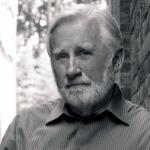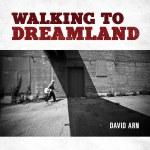

David Arn
There are deliberate songsters in the world that have a hum within themselves. They close their ears to outside influence and pull deep within themselves a breadth of internal sound to be exposed on a blank canvas of audio recording equipment. The process is an organic happenstance that shapes an audio landscape on which we the listeners can form a lucid dream in our minds. Their sonic visions create an audio track to our own imagination, or theirs, much like readers envision characters on the page. Some composers can offer up their sound to do just that. Their lyrics motivate the listener’s gears to turn, spinning cogs and wheels long dusted over with neglect. Their chord choices lay the ground work on which our imagination floats. David Arn is one of these composers. His audio choices are deliberate, unique, and interesting.
His music is simply complex so it may be easy to miss the intent. Upon closer inspection it is clear there was thought provoking intent that was deliberate and well thought out behind the songwriting, effects, instrument, and chord choices. Walking to Dreamland David’s second release reminisces on sounds from the 60’s and 70’s underground, a bit of 80’s jazz and a lot of David’s personality. His voice is earnest, focused, and gentle. His percussion choices are artistic, dramatically spaced between different sounds. The flow of the songs keeps you enraptured with the changes in melody and visual audio presentation.
The overall effect is of complete uniqueness. Pulling from a variety of genres, musical methodology, instrumentation and synthesizers, and personal influence, Walking to Dreamland evokes just that. To listen effectively I suggest closing your eyes, lying in bed, and letting the sounds wash over you. Such unique music should not be approached on the go, (unless your driving for the sake of spacing out) in between errands, or the like. Fans of The Microphones and Matthew Dear will appreciate his experimental notions, and those of Van Dyke Parks will appreciate the juxtaposition of sound and song style.
Upon complete listen of Walking to Dreamland it is clear that the word interesting used to describe it fits completely. The songs differ from one to the next like half brothers. Their related, but don’t look terribly alike. David’s songwriting exists in a vast stream of consciousness and at times can be beautifully simple, and at others disconcerting and haunting. There are vocals on some, and on others he chooses to invoke mood through sound. The result is a highly encapsulating thoughtful effect that leaves the listener’s mind provoked. It’s like a mix-tape from David’s brain sent straight to yours.
Where are you from?
I was born in Ohio. I have lived mostly on the East Coast of the US; New Jersey, Connecticut, and Virginia.
When did you first start playing music?
In my family, piano lessons at an early age were mandatory. So I was exposed to classical music early. Then I discovered New York rock radio stations. That’s when I begged off on the lessons. In retrospect, this training was invaluable because it taught me to think musically. I can play by ear. As a young boy, a neighborhood band would ask me to figure out chords to songs. My parents would throw parties and in the early morning hours they would wake me up and drag me down to the piano to play Sinatra and Beatles for their friends to sing along.
Was anyone pivotal in helping you to get where you are?
I have had encouraging teachers but the person that stands out is the father of one of our band mates. We were in high school. He encouraged us in a gentle way. He helped us get gigs and get our pictures in the local newspaper. He coached us on what he thought was working. He did not have a musical background but every now and then when I write, I sometimes hear Stan’s voice in the back of my mind, reminding me to “give people a beat they can dance to.”
How do you record your music?
I am fortunate to have an excellent home studio for developing ideas. I am also fortunate to have Rob Ulsh at Master Sound Studios in Virginia Beach. I’ve been working with Rob for four years now. He has decades of experience and has recorded many well-known artists. To watch him work is an education. In some cases the only way I can work with a talented artist like cellist Anat Nevo or Raz Ben Ari, is by exchanging high quality files. I know my limits. I seek out a good engineer like Rob Ulsh to work his magic. In the case of Walking to Dreamland it was then mastered by Yoad Nevo, in his London studio.
What does your songwriting process look like?
For me, it usually begins with a lyric. I am a more confident writer than singer. I am constantly putting words and phrases into folders on a laptop. The idea for a song is usually generated by an emotional response to a personal event. If I remain focused on my own experience, the words and ideas flow naturally. The older I get the easier the writing becomes because of a deeper well of experiences from which to draw. Once I have a lyric I sit down at the piano and apply musical ideas. lt is a repetitive process until something materializes that I am pleased with. You reach the point where the roadmap suddenly becomes clear. It is an emotionally charged moment. Ten minutes earlier the song did not exist; now somehow it does. Next I experiment with arrangements. Then I start reaching out to musicians.
Can you tell me about some of your recent projects?
On February 1st I released my second album. lt’s called Walking Dreamland. It is amusing to me to see how reviewers describe it. One recently described it as a “trippy musical journey.” And I suppose it is in a way. There are ten different tracks in various musical styles. Each of us has this place we think we are headed toward at the end of the walkway, but sometimes strange unforeseen events happen along the way. That project is now available on iTunes and Amazon Mp3. I’ve just released a video for the title track Walking to Dreamland and on the day the album was released another video went public for a song called “When you Lost Your Situation.” There are other videos coming out over the next few months.
What influences you musically?
It may sound strange but I don’t listen to a lot of music. Perhaps I fear that someone else’s ideas might creep in. The people I admire most are songwriters who craft songs in unique ways. Elliott Smith, for example. Chart his chord structure and modulations and you have to admire their complexity. ln my mind I draw a straight line from him to the early work of Van Dyke Parks. lt’s music that is intellectually interesting and complex. I also like Mark Oliver Everett and Matt Berninger for similar reasons.
What are your top ten favorite musical artists or bands?
ln no particular order—Elliott Smith, The National, Leonard Cohen, Tom Waits, Bob Dylan, Tim Easton, Eels, Elvis Costello,Willie Nile.
Can you tell me about the video making process?
Making videos helps me create better songs. I make certain the imagery is more concrete and that the song tells a story. My goal is to create, within a limited budget, videos that are interesting and a little off center. The recent video for “When You Lost Your Situation” is a good example.
Did you have a director?
It was a collaborative effort. I brought the song. I reached out to a writer I know. He gifted me with a script for the entire song. I sent that to Nika Ostoic, who had been in several music videos in Eastern Europe. She loved the idea, added ideas of her own, and then it took on a life of its own.
What was the inspiration for the video?
A close friend committed suicide by a deliberate overdose. I have always carried some guilt that I did not do enough to prevent the downward spiral. In the song and video I am reaching out.
Can you tell us about the people involved in the film?
Nika Ostoic is a journalist for Playboy, an alternative model, and aspiring actress. She was the creative driving force behind the production. She brought the talent together–Cathy Fox an artist and S&M entertainer, Paul John a queer entertainer from Vienna, Stjepan Vudrag a Playboy journalist, and Matija Vasic a professional translator based in The Hague, NL. Filip Dizdar, a popular singer in the Adriatic area, as well as a talented filmmaker, filmed and edited the project. I wanted him to emulate a Fellini or Quentin Tarantino style. Filip’s talent for timing is obvious in the video. As far as music videos go it is long (over five minutes) and yet the film visually pushes you along so you never lose interest.
Walking to Dreamland Official Video
<iframe width=”560″ height=”315″ src=”https://www.youtube.com/embed/OaZQNVkzbYw” frameborder=”0″ allowfullscreen>What was your favorite part about making it?
Seeing the creative energy others brought to the project. Once I was confident others grasped the concept, I let go. The temperature of the project began to climb. Everyone was excited. It was gratifying to watch it develop.
What’s Next?
I have written songs for another project but have not yet recorded anything. My goal is to sit down with a group of musicians and record them in way that is more organic. You can track the progress at http:// www.davidarn.com/ or on my Facebook page https ://www.facebook.com/DavidArnMusic
Anything Else?
I would just like to thank you, Angel, for giving me an opportunity to appear here on Sergeant Sparrow. This is a very classy and smart site. I am very grateful to be here.


